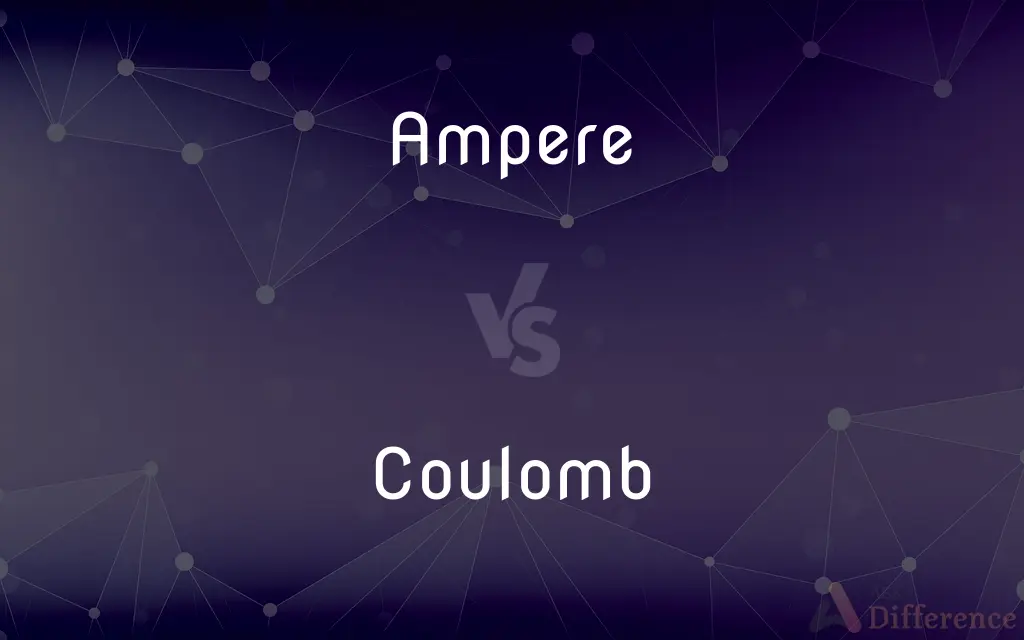Ampere vs. Coulomb — What's the Difference?
By Tayyaba Rehman — Updated on September 30, 2023
Ampere (A) is the unit of electric current, representing flow of charge per second; Coulomb (C) is the unit of electric charge. Both are fundamental units in electromagnetism, measuring different aspects of electricity.

Difference Between Ampere and Coulomb
Table of Contents
ADVERTISEMENT
Key Differences
Ampere and Coulomb are fundamental units in the field of electromagnetism but measure different aspects of electrical phenomena. Ampere, abbreviated as A, represents the flow of electric charge, or current, through a conductor. It quantifies how much electric charge passes a point in a conductor per second. On the other hand, Coulomb, represented by C, is the unit of electric charge itself, quantifying the amount of electricity conveyed.
The Ampere is the standard unit of electric current in the International System of Units (SI), named after André-Marie Ampère, a founder of the science of classical electromagnetism. It essentially measures the flow rate of electric charge. In contrast, a Coulomb, named after Charles-Augustin de Coulomb, is the amount of charge transported by a constant current of one ampere in one second. It acts as a quantitative representation of electric charge in a system.
In practical terms, an Ampere is equivalent to one Coulomb of charge passing through a point in one second. Hence, it reflects the movement or flow of electric charge, providing insights into the dynamic aspect of electrical phenomena. Conversely, the Coulomb, by representing the amount of electric charge, gives a static quantification, offering a measure of electric charge irrespective of its motion or flow.
Understanding the relationship between Ampere and Coulomb is pivotal for comprehending electrical circuits and electrical phenomena in general. While the Ampere illuminates the intensity of the electric current flowing through a circuit, indicating the rate of electric charge flow, the Coulomb provides insight into the quantity of the electric charge present in the system, offering a snapshot of the amount of electricity in a component.
In conclusion, Ampere and Coulomb, while related, are distinct units in electromagnetism. The Ampere symbolizes the flow or movement of electric charge per unit time, representing electric current, whereas the Coulomb is a measure of the electric charge itself. Both units together facilitate a comprehensive understanding of electrical phenomena, allowing for the quantification of both static and dynamic aspects of electricity.
ADVERTISEMENT
Comparison Chart
Measures
Electric Current (flow of electric charge)
Electric Charge
Units
A (Amperes)
C (Coulombs)
Definition
Amount of charge flowing per second
Amount of charge transported by a current of one ampere in one second
Practical Usage
Indicates the intensity of the electric current in a circuit
Represents the quantity of electric charge in a system
Named After
André-Marie Ampère
Charles-Augustin de Coulomb
Compare with Definitions
Ampere
Standard unit of electric current in the International System of Units (SI).
The symbol for ampere is ‘A’ in the SI system.
Coulomb
Unit of electric charge in the International System of Units (SI).
One coulomb is the amount of charge transported by a current of one ampere in one second.
Ampere
Unit of electric current representing flow of charge.
A 10-ampere current flows through the wire.
Coulomb
Named after Charles-Augustin de Coulomb.
The unit coulomb was established in honor of Charles-Augustin de Coulomb's pioneering work in electrodynamics.
Ampere
Named after André-Marie Ampère, a founder of classical electromagnetism.
André-Marie Ampère's work led to the definition of ampere as a unit of electric current.
Coulomb
Measures the amount of electricity conveyed.
A capacitor might store a charge of several coulombs.
Ampere
Indicator of intensity of electric current in a circuit.
A higher ampere value signifies a higher current flowing through the circuit.
Coulomb
Quantitative representation of electric charge.
The battery has a charge of 5000 coulombs.
Ampere
Amount of charge flowing per second.
An ampere is equivalent to one coulomb of charge per second.
Coulomb
Represents quantity of electric charge irrespective of its motion.
A coulomb provides insight into the amount of static electric charge in a component.
Ampere
The ampere (, US: ; symbol: A), often shortened to amp, is the base unit of electric current in the International System of Units (SI). It is named after André-Marie Ampère (1775–1836), French mathematician and physicist, considered the father of electromagnetism.
Coulomb
The coulomb (symbol: C) is the International System of Units (SI) unit of electric charge. Under the 2019 redefinition of the SI base units, which took effect on 20 May 2019, the coulomb is exactly 1/(1.602176634×10−19) elementary charges.
Ampere
The basic unit of electric current, equal to one coulomb per second and equivalent to the current, flowing in two straight parallel wires of negligible cross section separated by a distance of one meter, that produces a force between the wires of 2.0 × 10-7 newtons per meter of length. The value of an ampere in the International System differs very slightly from that in the meter-kilogram-second-ampere system of units. See Table at measurement.
Coulomb
The basic unit of electric charge, equal to the quantity of charge transferred in one second by a steady current of one ampere, and equivalent to 6.2415 × 1018 elementary charges, where one elementary charge is the charge of a proton or the negative of the charge of an electron. A coulomb's value in the International System differs very slightly from that in the meter-kilogram-second-ampere system of units. See Table at measurement.
Ampere
A unit of electrical current, the standard base unit in the International System of Units; colloquially amp. Abbreviation: amp, Symbol: A
Definition: The ampere, symbol A, is the SI unit of electric current. It is defined by taking the fixed numerical value of the elementary charge e to be 1.602
X 10−19 when expressed in the unit C, which is equal to A
S, where the second is defined in terms of ΔνCs. ([https://www.bipm.org/en/si-base-units/ampere The International Bureau of Weights and Measures])
Coulomb
Of or relating to the Coulomb force.
Ampere
The unit of electric current; - defined by the International Electrical Congress in 1893 and by U. S. Statute as, one tenth of the unit of current of the C. G. S. system of electro-magnetic units, or the practical equivalent of the unvarying current which, when passed through a standard solution of nitrate of silver in water, deposits silver at the rate of 0.001118 grams per second. Called also the international ampère.
Coulomb
In the International System of Units, the derived unit of electric charge; the amount of electric charge carried by a current of 1 ampere flowing for 1 second. Symbol: C
He is charged up with enough coulombs to make his hair stand on end.
Ampere
A former unit of electric current (slightly smaller than the SI ampere)
Coulomb
The standard unit of quantity in electrical measurements. It is the quantity of electricity conveyed in one second by the current produced by an electro-motive force of one volt acting in a circuit having a resistance of one ohm, or the quantity transferred by one ampère in one second. Formerly called weber.
Ampere
The basic unit of electric current adopted under the Systeme International d'Unites;
A typical household circuit carries 15 to 50 amps
Coulomb
A unit of electrical charge equal to the amount of charge transferred by a current of 1 ampere in 1 second
Coulomb
French physicist famous for his discoveries in the field of electricity and magnetism; formulated Coulomb's Law (1736-1806)
Common Curiosities
How many coulombs are transported by one ampere in one second?
One ampere transports one coulomb of charge in one second.
Is an ampere named after André-Marie Ampère?
Yes, the ampere is named after André-Marie Ampère, a founder of the science of classical electromagnetism.
Does an ampere represent the flow of electric charge?
Yes, an ampere represents the flow of electric charge per second.
Is a coulomb a unit of electric charge?
Yes, a coulomb is the unit of electric charge in the International System of Units (SI).
Is the symbol for ampere ‘A’?
Yes, the symbol for ampere is ‘A’.
Does a coulomb measure the amount of electricity conveyed?
Yes, a coulomb quantitatively represents the amount of electricity conveyed.
Is one ampere equivalent to one coulomb of charge per second?
Yes, one ampere is equivalent to the flow of one coulomb of charge per second.
Does an ampere indicate the intensity of electric current in a circuit?
Yes, an ampere indicates the intensity of the electric current flowing through a circuit.
Is a coulomb named after Charles-Augustin de Coulomb?
Yes, the coulomb is named after Charles-Augustin de Coulomb.
Is an ampere a standard unit in the International System of Units (SI)?
Yes, the ampere is the standard unit of electric current in the International System of Units (SI).
Can a coulomb provide insight into the amount of static electric charge?
Yes, a coulomb represents the quantity of electric charge irrespective of its motion, providing insight into the amount of static electric charge.
Share Your Discovery

Previous Comparison
Recollection vs. Retreat
Next Comparison
Beat vs. RhythmAuthor Spotlight
Written by
Tayyaba RehmanTayyaba Rehman is a distinguished writer, currently serving as a primary contributor to askdifference.com. As a researcher in semantics and etymology, Tayyaba's passion for the complexity of languages and their distinctions has found a perfect home on the platform. Tayyaba delves into the intricacies of language, distinguishing between commonly confused words and phrases, thereby providing clarity for readers worldwide.














































